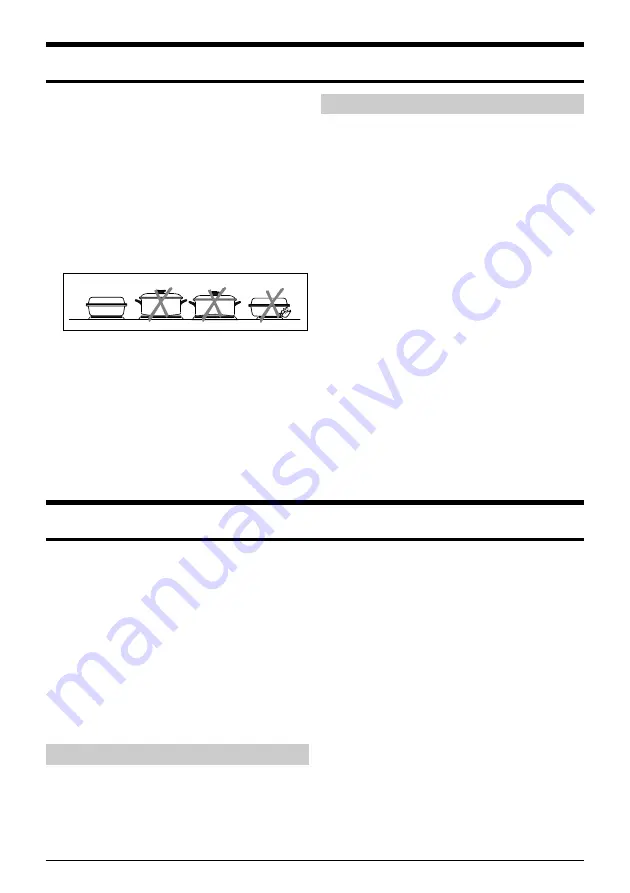
Instructions for Use, Building- in and Connecting
10
Cookware
Use high quality cookware with flat and solid
bottom.
x
During cooking place the pot in the middle of
the hotplate.
x
When using special cookware made of heat
resistant glass or porcelain, always follow the
manufacturer's instructions.
x
When cooking in the pressure cooker keep it
under constant surveillance until adequate
pressure is obtained. Hotplate should operate
at highest power at the beginning, then the
power should be reduced according to the
manufacturer's instructions.
Hotplates may be damaged:
x
if switched on and left empty, without adequate
dish, or if an empty dish is placed upon it;
x
if the cookware used is inadequate, for example
having crooked bottom, or
if the diameter of
the bottom is too small
for the hotplate
(coffee pot);
x
Prior placing the pot upon the hotplate wipe the
pot bottom dry to provide unobstructed thermal
conductivity and to prevent damage to the
hotplate.
Energy saving tips
x
The best transfer of energy is obtained if the
bottom of the dish is slightly bent towards the
inside.
x
The bottom diameter of the dish must suit the
diameter of the hotplate. The loss of energy is
greater if the dish is too small, and the hotplate
may be damaged.
x
Use pot lids and cover your cookware
whenever possible.
x
The dish size should always suit the quantity of
food. Excessively big pot for small quantity of
food wastes too much energy.
x
Dishes requiring long preparation should be
prepared in the pressure cooker.
x
Vegetables, potatoes, etc. may be cooked with
reduced quantity of water. The cooking is
shorter, however, the lid must be tightly placed
upon the dish. Once the water has reached the
point of boiling reduce the cooking power and
continue with slow boiling.
x
Reduce power regulation towards the end of
cooking, and switch the hotplate off 5-10
minutes before cooking is complete, to be able
to use the remaining heat.
Cleaning and maintenance
The appliance should be cleaned with warm
water, liquid detergent and soft cloth. Never use
aggressive cleaners and sharp objects. Burned or
dried food particles should be moistened with a
wet cloth and softened with an appropriate
cleansing agent.
Stainless steel surfaces must be cleaned with
special cleaners for stainless steel. Apply a fine
layer of the cleaner with a dry, well absorbing
cloth to the dried and cool surface, and rub in the
direction of the surface treatment. Stubborn
stains should be removed with wet cloth and then
rubbed dry with a dry cloth to the brilliance. Never
use such cleaners for cleaning of aluminum.
Cooktop hotplates
Cool the hotplates to at least 50°C before
starting to clean them!
x
Food leftovers
on the hotplates
are removed
with soft wet cloth or a sponge. To maintain the
appearance of hotplates you may use a few
drops of special hotplate agent and rub it in.
Never apply butter, lard and the like, as you
might provoke corrosion.
x
Hotplate rims
are made of stainless steel
and
might assume yellow colour with time, because
of the temperature effect. This is a physical
phenomenon, and it may be partly removed
with the appropriate metal cleaning agents. Mild
cleansing agents will not remove the yellow
film, while the aggressive abrasive cleaning
accessories might cause scratches.
x
Hotplates and the surrounding area
should be
cleaned with warm water, liquid detergent and
soft cloth. Soak any stubborn dried stains with a
wet sponge. In case of stainless steel cooktop
the hotplate surrounding may become yellow
with time. Remove the yellow colour with the
usual stainless steel cleansing agents.






